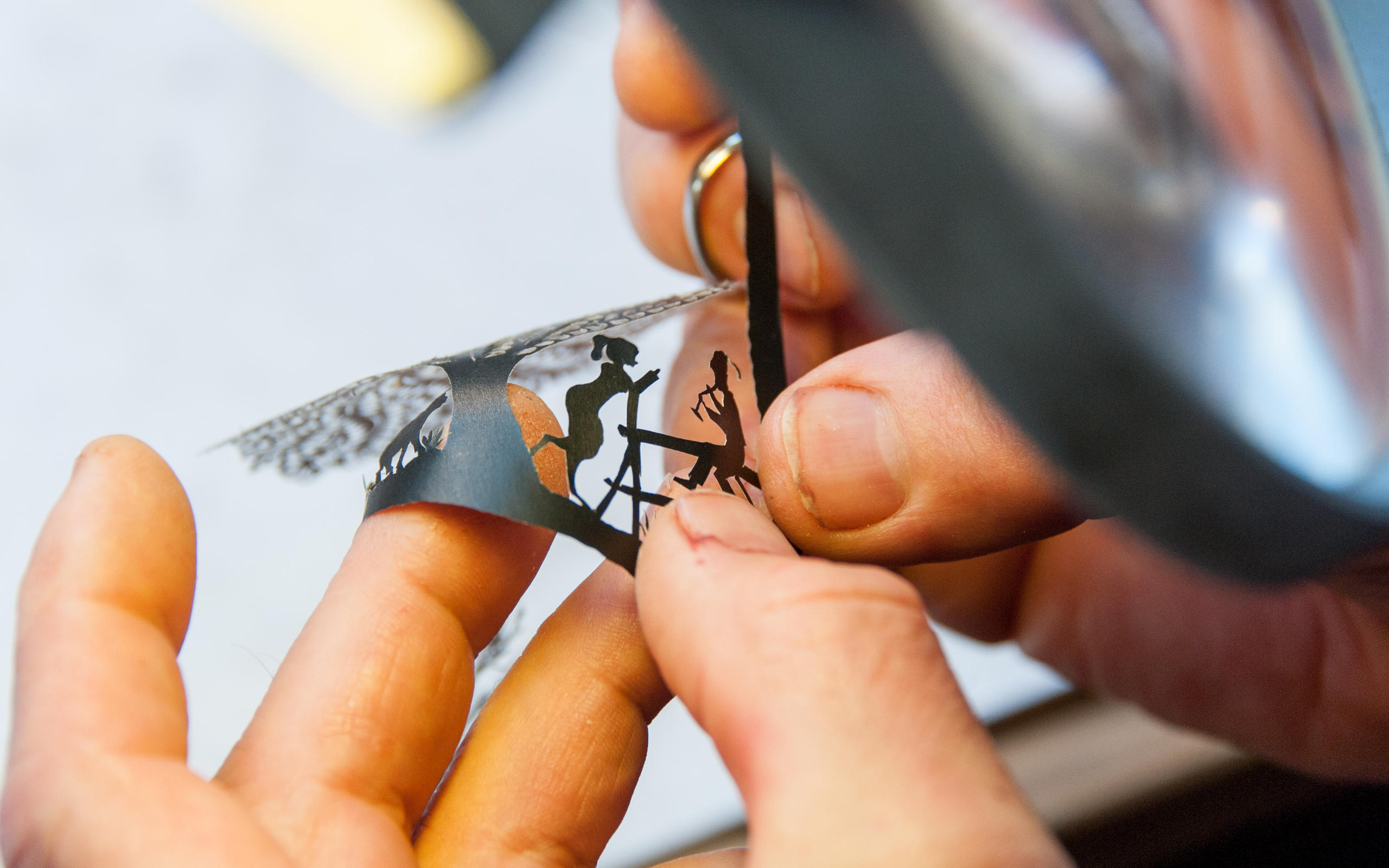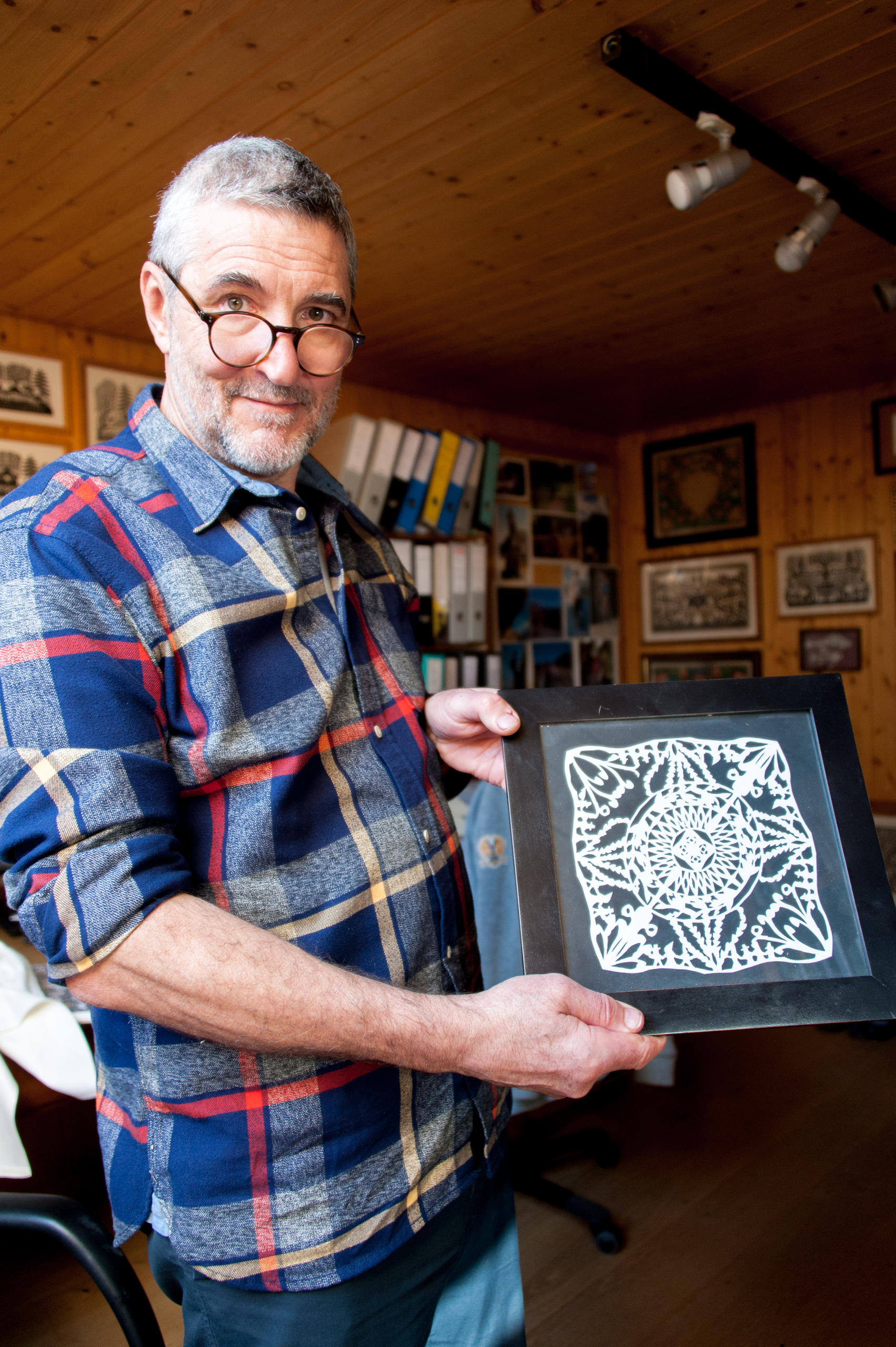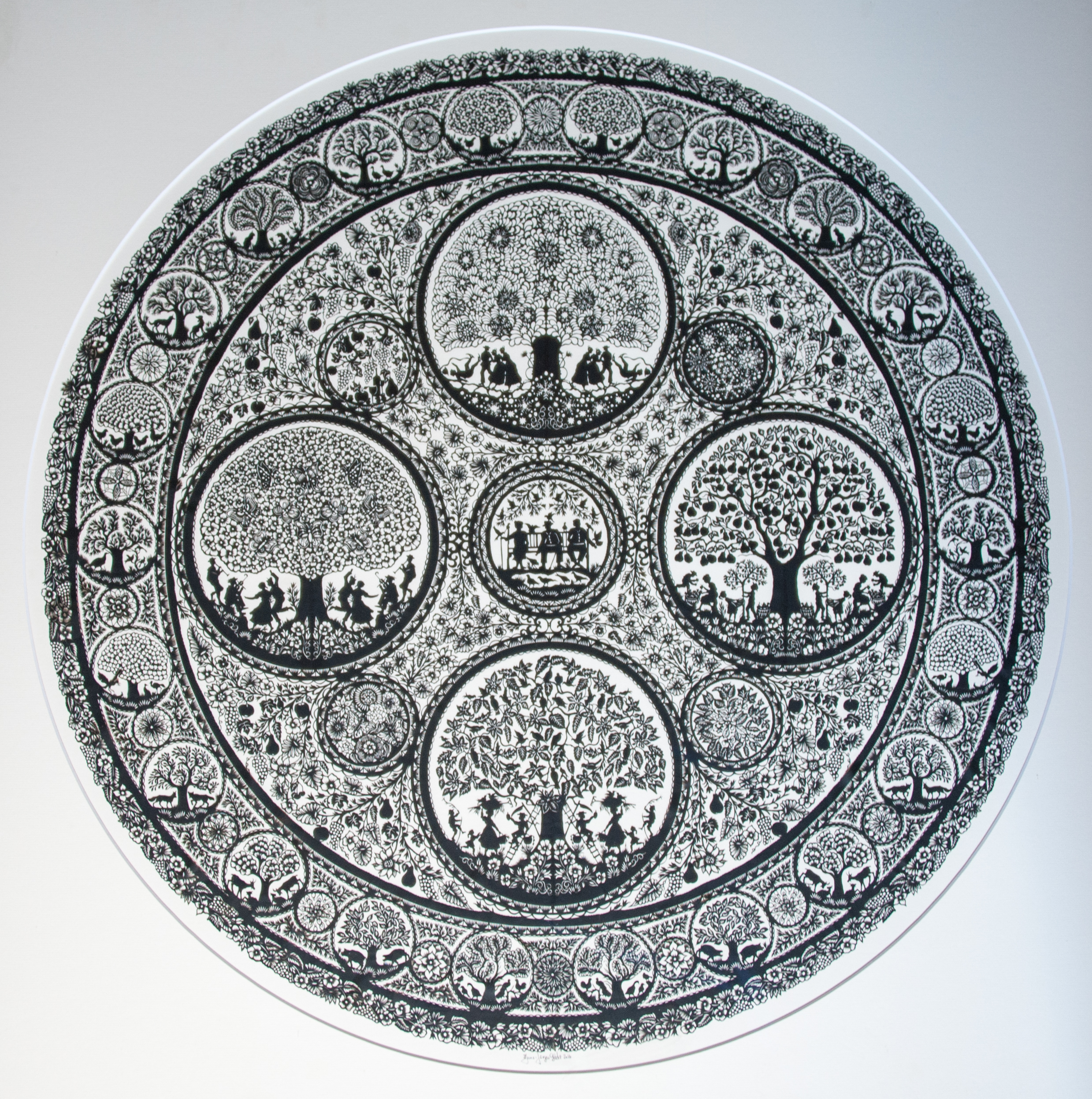Carving meat by day, cutting paper by night

Visitors to the Restaurant Hüsy in Blankenberg, canton Bern, might be drawn in by the smell of lamb chops, but their eyes immediately focus on the beautiful lace-like paper cuttings hanging on the walls.
As a child, you might have made snowflakes by folding and cutting pieces of paper. But Hans-Jürgen Glatz takes this originally Asian technique to another level. Combining it with psaligraphy (using cutting tools to create scenic or ornamental silhouettes), Glatz produces incredibly intricate black-and-white works of art which bring an aura of serenity to his restaurant.
More than 30 years ago Glatz, who comes from the Black Forest in Germany, met a Swiss girl on the shores of Lake Thun in the Bernese Oberland, an encounter that led not only to marriage, but also to a second career as a paper cutting artist.
Glatz, who is now the restaurant’s owner and chef, is also on the board of the Swiss Paper Cutting Association and is a well-known figure in the Swiss paper cutting community.
The Swiss Paper Cutting AssociationExternal link (Scherenschnitt Schweiz) has around 500 members, of whom 320 are active paper cutters. Some 30% are men.
40% of active members come from canton Bern, 30% come from western Switzerland and 20% from the eastern part of the country. The rest are from Italian-speaking areas and Valais, in south-western Switzerland.
His traditional three-story wooden building, which serves as a restaurant, a museum and an archive, houses nearly 600 paper cuts – Scherenschnitt (scissor cut) in German – from the association in addition to his own personal collection and creations.
Inspiration from wife
After marrying, Glatz and his wife settled in Switzerland. One day in 1990 he saw a paper cutting by Christian Schwizgebel in a shop in Gstaad and was blown away. “It’s so gorgeous,” he said. But it was also incredibly expensive! For a young man who had just started work in a Swiss restaurant, the price was way beyond his means.
Glatz told his wife about what he had seen. He didn’t expect her to immediately say: “Why can’t you cut it yourself?”

So one day, when the restaurant wasn’t so busy, Glatz used nail scissors to make his first paper cut in the kitchen, which he did by folding a square piece of white paper. This symmetrical paper cut still hangs in his office. Although the head chef at the time kept telling him, “Don’t bother – you’re not cut out for this”, Glatz knew that he was.
Glatz’s skills attracted more and more attention, and his friends and family began making requests. As a result, he gradually gained his own customers.
Over the years the autodidact has produced about 280 works. The largest measures 150cm x 79cm and took more than 500 hours to cut. Since he lives in a small village and spends much of his time on a farm looking after livestock, most of Glatz’s works depict scenes from the lives of herdsmen in the Alps.
Humour and imagination
Glatz excels at large-scale paper cutting and has a special interest in animals. His works are mainly black and white, with a few colourful exceptions.
At first glance, they are mostly serious and dignified. But walk into the restaurant’s toilets and you will laugh at the scenes inside; Glatz is certainly not a staid and unadventurous craftsman, and in this private little world there are many witty and humorous works full of imagination.
His style of paper cutting is very different from that found in his archive collections – it’s like suddenly shifting from an agrarian society into a modern metropolis where the characters have a strong contemporary feel. It turns out that the seemingly discreet art of paper cutting can also be free and unrestrained.
Glatz also enjoys creating works with female subjects, ranging from the witty to the absurd. For example, in depicting traditional Alpine herders, some girls have been changed from wearing traditional long skirts to short skirts and from wearing traditional headdresses to ponytails.
From conception to completion
A work generally goes through the steps of rough idea, conception, composition, drawing, cutting, repairing, and assembling. And it can take time. For example, Glatz’s recent round piece, the 68cm-diameter “Four Seasons”, took 230 hours to move from conception to completion. Patience is a virtue when it comes to paper cutting.
On this particular piece, it’s almost impossible to see the details without a magnifying glass. Glatz said that not all the details were drawn in advance, but rather done with scissors using imagination and feeling as he went along.

Take the small circular part on the left, representing spring. The butterflies in it were roughly sketched before cutting, while the densely branched canopy and leaves were difficult to draw and could only be created spontaneously during the cutting itself. If Glatz makes a mistake – as happened on a small branch – this can be fixed. In the final step the various parts of the work were put together.
Swiss tradition
Paper cutting is a folk art that reflects the 200-year history of Swiss agriculture and animal husbandry and has had a major influence on Swiss culture, Glatz explained. Paper cutting used to be a pastime for people during the long winter months; it even served to spread religion.
Today, it is still a vibrant art form in Switzerland, and people continue to learn about history through paper cutting.
Glatz devotes at least two hours a day to his passion, and now that the restaurant is closed because of the Covid-19 pandemic he has even more time to spend. For him, paper cutting is a part of his life. However, since both cooking and paper cutting involves his hands, his right index finger often aches owing to overuse and he has to apply an ointment. What’s more, because of the strain on his eyes, he now can’t cut paper without a magnifying glass.
“It would be terrible and unimaginable if one day I couldn’t cut paper anymore,” he said. “But life will go on.”
Paper cutting originated in Asia around 2,000 years ago, where objects similar to today’s cuttings were made from animal hides. Then, after the Chinese invention of papermaking, cutting began to develop rapidly. The art was used extensively in Chinese shadow puppet shows and came to Europe via the Silk Road. The earliest documented Swiss paper cuts appeared in 1696. Hans-Jürgen Glatz’s collection includes the second-oldest Swiss paper cut, which dates from 1701 (see gallery).
In the 19th century Johann Jakob Hauswirth (1809-1871) introduced traditional paper cutting to Switzerland.
Today paper cutting as a folk art can still be found widely, and as a means of communicating and passing on emotions and memories it still holds great significance in people’s lives and culture.
When asked if artificial intelligence could replace humans in paper cutting, Glatz said computers could certainly do it someday, but computerised paper cutting is soulless and the work does not convey emotion as it is not created with heart and soul: a computer makes a product, a human creates a work of art.
In order to pass on the art of paper cutting, Glatz occasionally holds workshops. He finds that the younger generation is still very passionate about paper cutting, and the level of talent among them leaves him with plenty of optimism for the future.
He normally organises two paper cutting exhibitions every year in the Restaurant Hüsy, from January to April and from September to November, featuring the works of different master paper cutters.
Switzerland’s largest exhibition is held every three years, with the next one to be held at the Hans Erni MuseumExternal link in Lucerne in 2022, showcasing the work of the best Swiss paper cutters.

More
Paper cutting moves on into the 21st century

In compliance with the JTI standards
More: SWI swissinfo.ch certified by the Journalism Trust Initiative



















Join the conversation!